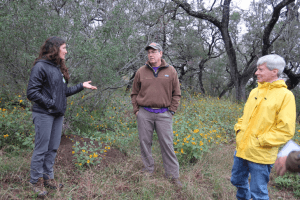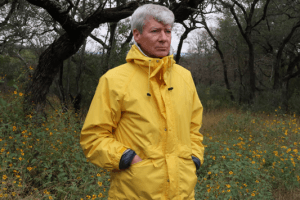On Nov. 9, our class took a field trip out to the Spicewood Ranch in, you guessed it, Spicewood, TX. The ranch is owned by Chris Harte, a local Austinite (who doesn’t own a car), and managed by Allen Spelce, who works on controlling the deer population, and David Mahler, a well-known restoration ecologist in central Texas. The land was first purchased in 1972 by Chris’ father and uncles as a place for the boys to learn ranching and other skills. After Chris married his late wife Kay, she pushed him to pursue more restoration work on the property and along with help from David Mahler, convinced Chris of the importance of restoring and conserving the land. Since the purchase of the initial track Harte has made over 35 land transactions to acquire surrounding property as is goes up for sale. Today the ranch spans some 1300 acres throughout the Hill Country. Cattle have been removed from the ranch for the past 30 years to help ease stress on the land and botanist Bill Carr has identified over 500 species of plants throughout the property. In 2018 Chris won the TPWD Lone Star Steward Award for the restoration work he does on his property.
The most significant change they have been working to implement on the ranch is trying to control the deer population. Allen Spelce, the head deer manager said that when they first started the population was around 1 deer for every 3 acres, now they have it down to about 1 deer per 15 acres and would ideally want 1 deer per 20 acres. They is made possible because of the high game fence surrounding their ranch, put up to keep deer out rather than keep animals in. They have also received a Managed Land Deer Permit (MLDP) obtained through Texas Parks and Wildlife around 8 or 9 years ago. The MLDP allows them a much longer (5 month compared to 2 month) season to take as many deer as they want. Texas Parks and Wildlife works with MLDP owners to both teach and learn about restoration practices throughout Texas. Allen Spelce and volunteers make use of the MLDP every year by hunting more deer and basically reintroducing a “natural” predator back into the deer’s environment. They make sure to take an even range of deer as to not take more bucks than doe or vice versa. Because of these management practices, they have actually seen deer increase in size by about 20% versus what they started with. Additionally, they have a higher population of bucks on the ranch than does which is typically the opposite of almost every low fence ranch. By reintroducing a predator they are helping to decrease the density of deer allowing stress on plants and the environment to ease.
When David Mahler first started working on the land he noticed something interesting: there were not many young to middle aged hardwoods present on the land. They would find full grown Post and Red oaks and maybe see a few saplings but nothing in between. Chris and David hypothesized that because the deer population was so high and because much of the land had been choked out by overpopulated Ashe Juniper or invasive KR Bluestem the deer were forced to eat these young hardwoods. This put increased stress on these species such as Post Oak and Evergreen Sumac, plants that Chris refers to as like ice cream for the deer. Through prescribed burns and seeding they have now reclaimed much of the invaded habitat and restored it back to a similar makeup of the native community. They have been doing research to back up these claims on the ranch and have had exciting success. By using high game fences to fence in small plots (ranging 5 to 30 acres) they have been able to drastically reduce or completely eliminate deer in the plots allowing them to test how some of the hardwoods and other native plants respond to the decrease or removal of deer. By adding other native forbs and grasses like Plateau Golden Eye and Side Oats Grama, they have given the deer a larger buffet to choose from. Now the deer put less stress on the ice cream-like plants and spread their diet out across a broader range leaving more opportunity for Evergreen Sumac, Post Oak and other hardwoods to mature.
One of the other main problems Harte deals with on his ranch are feral hogs and other exotic game that finds its way onto the ranch somehow. The feral hogs tear up the ground looking for small bugs to eat and can completely undermine some of the restoration efforts. Additionally, because Texas has such relaxed laws on bringing in exotic animals (if you have the money you can bring in almost any animal and hunt them year round) Harte battles with exotics like Axis Deer which eat almost everything all year. This makes restoration work very difficult to complete with numerous exotics willing to eat everything in sight.
Chris Harte, Allen Spelce and David Mahler have put in huge amounts of time and effort into restoring the land to its natural working order. Through their restoration research they hope to bring forward large scale management and restoration plans for the Hill Country area. They are very adamant about making sure that people realize controlling the whitetail deer density is crucial to establishing or reestablishing hard woods and other native forbs and grasses. And finally, in Texas with such little public land, restoration, especially large scale projects must involve the private landowners. If these landowners are not involved in the conversation efforts then most of the work will be an uphill battle. Chris’s Spicewood Ranch helps to provide an outline and success story for how private land owners can take the initiative to help restore the beautiful Texas Hill Country.
Chris Harte standing proud in front of a group of Plateau Golden Eye in the one of the first spots where the restoration occurred.
Photos by Paloma Ridge
Text by Jon Brooks and Paloma ridge



Leave a Reply